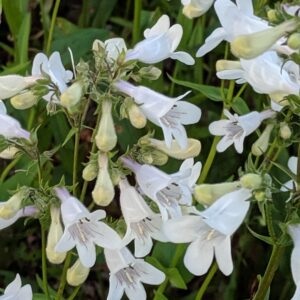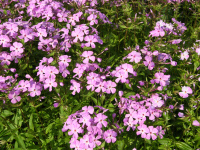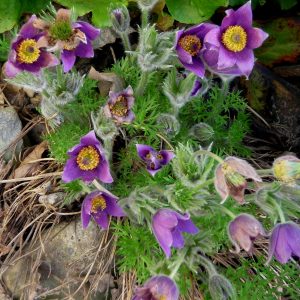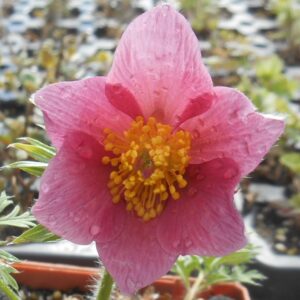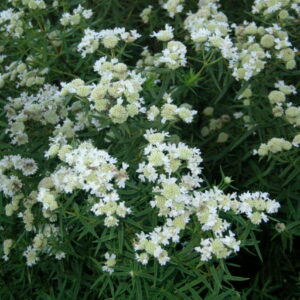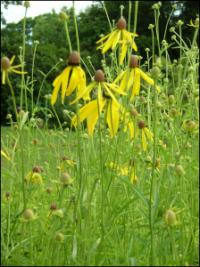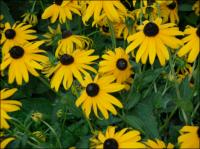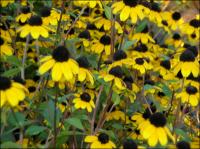Prairie Plants
Showing 65–72 of 85 results
-
Penstemon tubaeflorus Great Plains Beardtongue 4-8
Spikes of swan white trumpets with flared ends blooms in early summer. One of most reliable, long lived penstemons.
Spikes of swan white trumpets with flared ends blooms in early summer. One of most reliable, long lived penstemons.
Size: 2-3’x 15”
Care: Sun in well-drained to moist well-drained soil
Native: Central Plains N., S. to TX & NE to Maine, Wisconsin native
Wildlife Value: feeds Baltimore butterfly, other butterflies, bees and hummingbirdsPenstemon is named for its five stamens, penta meaning five and stemon meaning stamen in Greek. Collected by English botanist Thomas Nuttall (1786-1859) who searched entire No. American continent – parts of Canada, from New England west to Oregon, parts of the South, Midwest, the Plains, the S.E., California & Hawaii, finding hundreds of new plants.
-
Phlox buckleyi Sword leaf Phlox Z 4-8
Sprays of mauve, pink or purple in May-June
Sprays of mauve, pink or purple in May-June
Size: 8- 18” x 12”
Care: sun to part shade in any soil
Native: Virginia & West VirginiaDescribed and named by Edgar Theodore Wherry (1885-1982), unflagging naturalist in the finest tradition of wide interests in the natural world. After getting his Ph.D in 1909 in geology-mineralogy he became Asst. Curator of Minerals for the Smithsonian. In 8 years he transferred to the USDA Bureau of Chemistry, becoming its principal chemist. He left in 1930 to accept an appointment as botany professor at U. Penn., where he taught botany and ecology for 25 years.
**LISTED AS OUT OF STOCK BECAUSE WE DO NOT SHIP THIS ITEM. IT IS AVAILABLE FOR PURCHASE AT OUR RETAIL LOCATION.
-
Pulsatilla vulgaris Pasque flower Z 4-8
Nodding, bell-shaped purple petals with yellow centers flowers in early spring. Fun, furry foliage and Medusa-like seed heads.
Nodding, bell-shaped purple petals with yellow centers flowers in early spring. Fun, furry foliage and Medusa-like seed heads.
Size: 8" x 8"
Care: sun in well-drained to moist well-drained soil
Native: Europe
Wildlife Value: Deer resistant, early pollen source for bees.
Awards: Great Plants for Great Plains, Royal Botanical Society Award of Garden MeritCultivated in Europe since at least medieval times. Possibly used by the Druids (about 2000 years ago) in their festival of the dawn goddess. Grown in the Eichstätt Garden, the garden of Johann Konrad von Gemmingen, prince bishop of Eichstätt in Bavaria, c. 1600. Jefferson planted this in 1771 in a shrubbery at Monticello. Called Pasque flower because it blooms at Easter time, well maybe for gardens in Missouri or Maryland.
-
Pulsatilla vulgaris var. rubra syn. Anemone pulsatilla var. rubra Pasqueflower
Wine-red petals of bell-shape with yellow centers flowers in early spring. Fun, furry foliage
OUT OF STOCK
Wine-red petals of bell-shape with yellow centers flowers in early spring. Fun, furry foliage and Medusa-like seed heads.
Size: 12-20” x 4-8”
Care: sun in well-drained to moist well-drained soil
Native: Europe
Wildlife Value: Deer resistant, early pollen source for bees.Called Pasqueflower because it blooms at Easter time. Variety rubra considered a separate species, not a variety, by Caspar Bauhin in Theatri botanici, 1671. Illustrated in Gerard’s Herball, 1636.
-
Pycanthemum virginianum Mountain mint Z 4-8
Corymbs of numerous pinkish-white blossoms, leaves fragrant.
Corymbs of numerous pinkish-white blossoms in August, leaves fragrant.
Size: 3' x 18"
Care: full sun to part shade in moist well-drained to well-drained soil
Native: Wisconsin native, Eastern U.S.
Wildlife Value: attracts butterflies, supports over 50 bee species.Named by Linnaeus in 1753. Pycanthemum is Greek meaning “dense blossom.” Chippewa used it to stop menstrual flow, cure chills and fever and to season meat. The plant gave the Meskwaki energy and lured minks into their traps. Lakota Sioux: “The leaves make a very pleasant tea. An infusion of the plant is taken for coughs.” Grown at America’s 1st botanic garden, Elgin Botanic Garden 1811
-
Ratibida pinnata Prairie coneflower Z 3-8
Skirt of drooping, sunny, thin petals surround erect brown cone on this fragrant flower, smelling of anise, June-August.
Skirt of drooping, sunny, thin petals surround erect brown cone on this fragrant flower, smelling of anise, June-August.
Size: 4' x 18"
Care: sun to part shade in any soil
Native: Ontario, VT to FL, SD to OK, incl. Wisconsin
Wildlife Value: Butterfly plant. Birds eat seeds.Pinnata means “feathery” in Latin referring to the thin petals of the flower. 1st Americans cured toothaches with the root & made tea from the cone and leaves. Collected by French explorer Michaux on the prairies of Illinois in 1795.
-
Rudbeckia subtomentosa Sweet coneflower Z 4-8
Fragrant yellow daisies with purplish cones, July- October
Fragrant yellow daisies with purplish cones, July- October
Size: 4-5' x 1-2'
Care: Sun to part shade in moist to moist well-drained soil
Native: East US, Wisconsin native.
Wildlife Value: attracts butterfleisRudbeckia was named by Linnaeus for his University of Upsala professor, Olaf Rudbeck. Rudbeck made the surprising claim “that the Paradise of Scripture was situated somewhere in Sweden.” C.F. Level. This species described in 1815. May have been collected by English planthunter John Bradbury (1768-1823).
-
Rudbeckia triloba Branched coneflower, Brown eyed susan Z 3-9
Multitudes of small sunny daisies with brown centers from July to October, as cheery as they come.
Multitudes of small sunny daisies with brown centers from July to October, as cheery as they come.
Size: 3-4' x 2-3'
Care: sun to part shade in moist well-drained soil.
Native: most of North America, Wisconsin native
Wildlife Value: Numerous bees, some flies, a few wasps and butterflies feed on the nectar and pollen. One bee feeds only on Rudbeckias and Ratibida flowers.
Awards: Georgia Gold Medal winner. England’s Royal Horticultural Society Award of Garden Merit.Rudbeckia was named by Linnaeus for his University of Upsala professor and founder of the Uppsala botanic Garden, and his son, University of Uppsala professor named Olaf Rudbeck. This species collected in Colonial Virginia in 1600’s.

